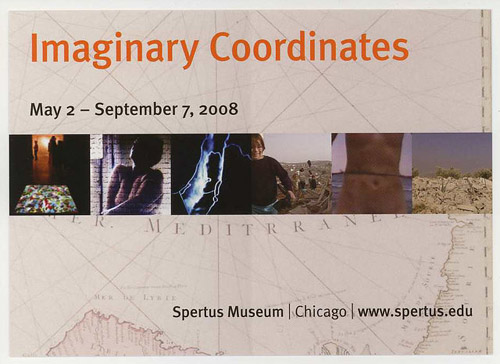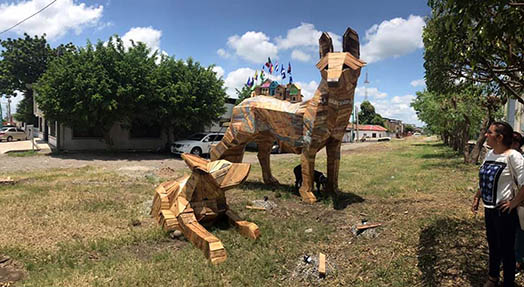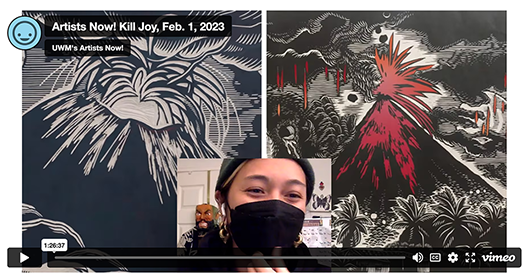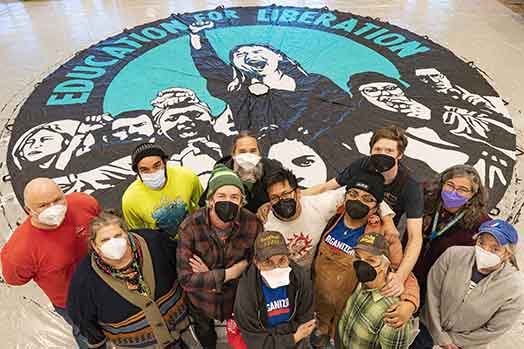
I recently saw the exhibition “Imaginary Coordinates” at the Spertus Museum in Chicago and was disappointed to learn that the exhibit was recently abruptly closed and will not run through the proposed closing date of September 7th. The exhibition was part of a city-wide theme in Chicago museums on mapping. Rather than taking the safe route, the Spertus Museum (which is a Jewish museum) organized a very compelling and courageous exhibition that looked at past and present maps that addressed the ever-changing borders and politics of Israel and Palestine. More so, the exhibition featured videos and installations by contemporary women artists responding to the larger issues at hand. The show was so commendable for it presented a myriad of views from both perspectives — a decision that was sure to draw heat from pro-Israel supporters who might object to seeing work that was critical of Israel and supportive of Palestine within a Jewish museum.
To ensure that the work was protected and that visitors understood the curator’s decision-making process, visitors to the exhibition could only view the show on a guided tour.
To me, the show represented a chance for dialog and a broader understanding of the complex issues at hand and the closing of the show represents the opposite.
Below is a recent post on the abrupt closing of the show that was written by Marc Fischer (that was first posted on the Temporary Services blog)
“By now, much has already been written about the sudden closing of the exhibition “Imaginary Coordinates” at the Spertus Museum in Chicago. The exhibition, which was to run from May 2 – September 7, 2008, was shut down on June 20th by order of Spertus President Howard Sulkin working in cahoots with Spertus’ Board of Directors. At the end of this post you can find some links that describe the situation as it unfolded. This link on Spertus’ website provides the basic details of the exhibition: http://www.spertus.edu/exhibitions/past/imaginary_coordinates.php
Until it is dismantled and the objects are returned to the artists, lenders and Spertus’ own collections, the exhibit will exist as a cultural crime scene. This is made stranger by the fact that the perpetrators are still safely nestled in their offices elsewhere in the building while the exhibition curator, artists, museum employees and countless visitors who hadn’t yet seen the show are left betrayed; they are the victims of a private process that has shut out many in order to protect the interests and concerns of a vast minority of Spertus’ audience.
How can a museum staff get excited about future exhibitions when they’ve just had all their hard work pulled out from under them? Will it happen again? What to say to visitors –- or artists that might take part in future shows – who will repeatedly ask what happened? The catalog for the exhibition, a typically fine-looking book design by Spertus’ own team, has all but disappeared. It has been pulled from display on the museum’s online store and copies of the book were hidden inside the building’s shop. It is not displayed with its cover facing outward as one would expect, but filed away quietly on a shelf. Spertus’ website explains nothing of what happened to “Imaginary Coordinates.” Already listed under the heading for “Past Exhibitions,” the dates have simply been adjusted to reflect the sudden closing on June 20th. There is no explanation why.
This is a very painful situation to observe, perhaps a bit more so for me because I worked at the Spertus Museum from 2000-2003, and know many people who still work there. I can’t imagine how dispiriting it must be to remain employed at the site of one of the most misguided measures in museological memory. When New York City’s then Mayor, Rudy Giulliani, tried, unsuccessfully, to shut down the exhibition “Sensation” at the Brooklyn Museum of Art in 1999, the attack came from outside of the institution. What happened at Spertus is unusual, for it is a case of in-house censorship that took place after the exhibit had already opened. Spertus is a private institution, but to have this happen in such a public and ugly manner should create a much-deserved public distrust for years to come. The museum runs the considerable risk of becoming a big gleaming private bauble; a huge, hollow diamond on Michigan Avenue filled with nice shiny things that its board members and President can polish from time to time, while maintaining a safe distance from difficult public discourse, challenging questions, and relationships with anyone not in consensus with the opinions of those in charge of fund-raising efforts and operating budgets.
Museums often plan and work on exhibitions for years and “Imaginary Coordinates” was no exception. It was three years in the making. Three years is a long time to have internal dialogues, to anticipate problems and prepare for them, to seek outside opinions with trusted colleagues or board members and to make changes privately, outside of the public eye. To close an exhibition in mid-flight, through a decision-making process that excluded the curator and artists, is truly shocking. I’m not even sure if there are precedents for an institution shooting itself in the foot quite like this.
“Imaginary Coordinates” was a carefully considered and meticulously crafted exhibition. It was not provocative in the manner that Steven Nasatir, president of building tenants the Jewish United Fund/Jewish Federation of Metropolitan Chicago – with his hysterical cries of “Anti-Israel” – has unsuccessfully tried to perpetuate in a Chicago Tribune article (linked below). The exhibition is evenly split between contemporary art and ancient maps of the Holy Land with compelling bits of material culture and personal affects included in between. Noting that all of the map-makers were male, the exhibition achieves a thoughtful curatorial gender balance by presenting only female artists. The melding of printed maps that are hundreds of years old with works produced as recently as this year is seamless and engaging.
As Temporary Services have long argued, the distinction between art and other forms of human creativity is irrelevant and this exhibition proves this repeatedly. An open book showing an embossed white page – a Braille map of Israel for the blind – speaks to this erasing of categorization between maps and works of art. The varied forms of the many maps on display shift radically in relation to what the maker wished to emphasize; subjectivity abounds in all disciplines, not only in art.
In my view there were no strictly polemical works in this show, no ideological agenda on the part of the artists and curator, and only the limitless powers of curatorial imagination to fear – for this was a show that ignored traditional boundaries between the classification of objects in order to achieve new perceptual possibilities. It provided many opportunities for dialogue and social exchange – in the form of events, survey/comment forms, and countless tours. For a museum so strongly devoted to Holocaust education, canceling this exhibition was an embarrassing act of in-house intolerance. Unlike “Sensation” – which featured numerous artworks that clearly made ham-fisted, empty and lame attempts to shock and provoke – “Imaginary Coordinates” featured far more subtle and complex works. I spent an hour and a half inside the exhibition on a tour led by Rhoda Rosen and I was still only able to see it in a cursory way. The show is unimaginable without contextual wall labels. The couple works that do feature nudity – a more obvious challenge for some viewers – are presented with care and consideration and visitors are warned of adult content when they step off the elevator.
The cancellation of “Imaginary Coordinates” should cast a dark shadow over the Spertus Institute for many years to come. It is unfortunate that this exhibit is poised to be remembered more for its very well publicized and almost universally condemned dismantling, than for its considerable merits as a showcase for curatorial creativity and artistic imagination. Nonetheless, this act of censorship should not be forgotten and the President and Board of Directors deserve to be publicly shamed for their poor judgment. We extend our support to Rhoda Rosen and the museum staff who are weathering the consequences of their leaders’ stupidity.
Marc
for Temporary Services (Brett Bloom, Salem Collo-Julin, Marc Fischer)
P.S. In August, when Temporary Services launches a store through our upcoming publishing entity Half Letter Press, we plan to sell copies of the exhibition catalog from “Imaginary Coordinates.” So look out for that in the future.”
Additional reading:
http://www.chicagoreader.com/features/stories/thebusiness/080529/
http://www.chicagotribune.com/entertainment/chi-080620-spertus-closes-show,0,6226254.story
http://www.timeout.com/chicago/blog/out-and-about/?p=4551
http://blogs.chicagoreader.com/chicagoland/2008/06/20/spertus-caves/







